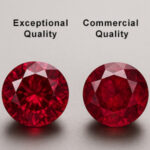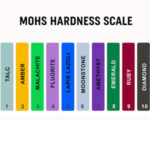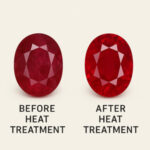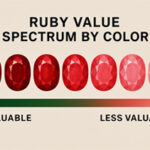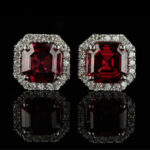rubies
rubies
Rubies are one of the three precious colored gemstones, alongside Emeralds and Sapphires. They are a variety of the mineral corundum, distinguished by their vibrant red color, which is caused primarily by traces of chromium. While corundum can appear in other colors — such as blue (sapphire) or pink (also sapphire) — only the red variety is called ruby. Rubies are treasured for their intense color, exceptional hardness, and historical significance. Known for their captivating beauty, rubies hold a special place among gemstones, celebrated for their deep, fiery hues and enduring symbolism.

Rubies: Composition, Formation, and Origins
Rubies belong to the corundum family, which also includes all sapphires. While sapphires can come in many colors, rubies are defined specifically by their rich red hue. The presence of chromium gives rubies their unmistakable color, ranging from pinkish red to deep blood red.
Where Are Rubies Found?
Rubies come from several key regions, each with distinct characteristics:
Myanmar (Burma): Known for the finest rubies, especially the vivid “pigeon’s blood” red from the Mogok region.
Mozambique: A major modern source, producing vibrant red to purplish-red stones with excellent clarity.
Thailand: Offers darker, garnet-like rubies with higher iron content, often less brilliant.
Others: Vietnam, Sri Lanka, and Tanzania also produce rubies with unique color and clarity variations.
BEAUTY BEGINS WITH COLOR
A ruby is appreciated and graded above all by its color. It is the ruby’s vibrant red hue that most significantly determines its value.
A richly saturated ruby will consistently command higher prices than a larger ruby with less desirable color, despite the rarity of large stones.
Ruby Clarity
Rubies, like emeralds, are Type II gemstones, meaning that some inclusions are expected and accepted. Eye-clean rubies are rare and extremely valuable.
Typical inclusions include rutile silk, needles, crystals, and fingerprint patterns. Fine rubies with minimal visible inclusions can command premium prices.
Unlike diamonds, ruby clarity is judged by the eye, not a loupe. Minor inclusions are acceptable as long as they do not significantly impact the stone’s transparency or brilliance.
Natural, Treated, and Synthetic Comparisons
Untreated Rubies: Rare and highly valued, especially when vivid red and transparent. No enhancements applied.
Treated Rubies: Commonly heat-treated to improve color and clarity. Properly disclosed, these retain good value. Glass-filled rubies are lower in quality and price.
Synthetic Rubies: Lab-made with identical properties to natural rubies but lack rarity—much lower in price.
Simulants: Look-alikes (e.g., red spinel, garnet, glass) with no true ruby properties—low value and durability
Ruby Durability
Rubies rank 9 on the Mohs scale, making them incredibly durable and suitable for daily wear. Their excellent toughness means they resist scratching and chipping better than most colored stones, second only to diamonds.
While inclusions can sometimes create weak points, a well-cut and properly set ruby can remain stunning and resilient for generations.
Ruby Treatments
Ruby treatments affect both value and durability. Heat treatment is common, stable, and accepted, enhancing color and clarity. Lead glass-filling, used on lower-quality rubies, improves appearance but lowers value and requires care. Untreated or heat-only rubies are most valuable. Always request certified disclosure of treatments.
valuing Rubies
Valuing rubies involves assessing several key factors that determine their rarity and worth. Color is the most important element, with the finest rubies displaying a vibrant, well-balanced red. Clarity, cut, treatments, origin, and certification also play vital roles in establishing a ruby’s quality and market value. Understanding how these aspects interact helps buyers make informed decisions and recognize exceptional stones.
Key Questions to Consider Before Buying a Ruby
Before buying a ruby, consider its color, clarity, cut, treatments, origin, and certification. Prioritize rich, well-balanced color and ask if inclusions affect brilliance. Ensure the cut enhances beauty, and check for treatments like heat or filling. Origin can influence value, with Burmese rubies being most prized. Always request certification from a trusted gem lab.




